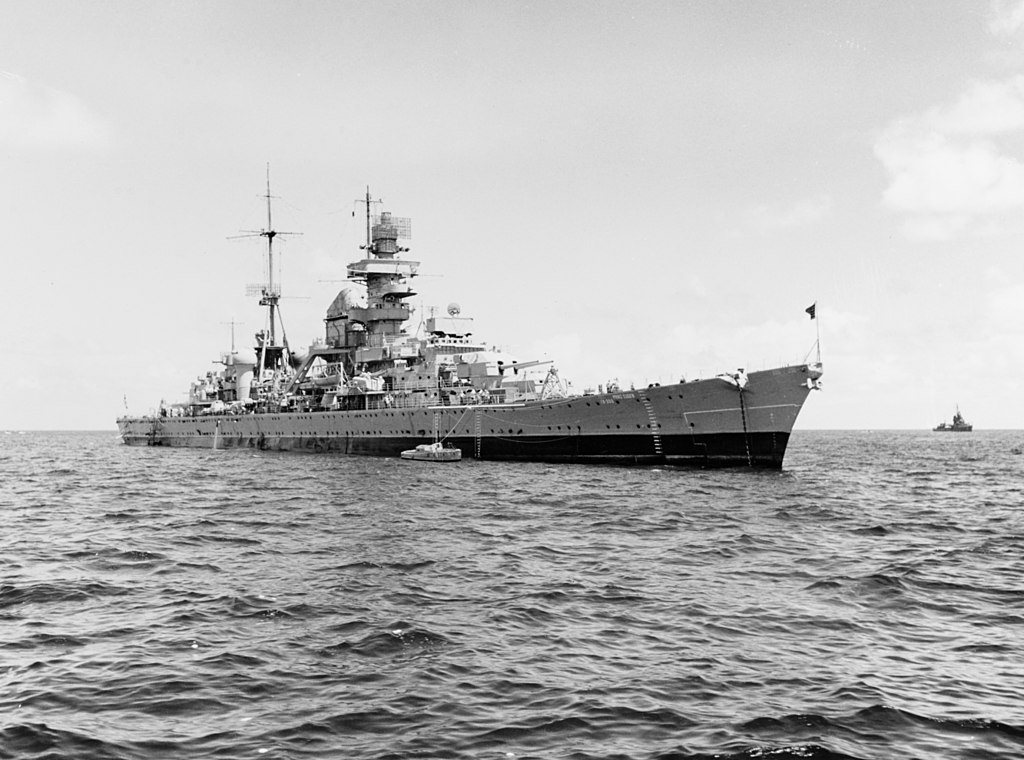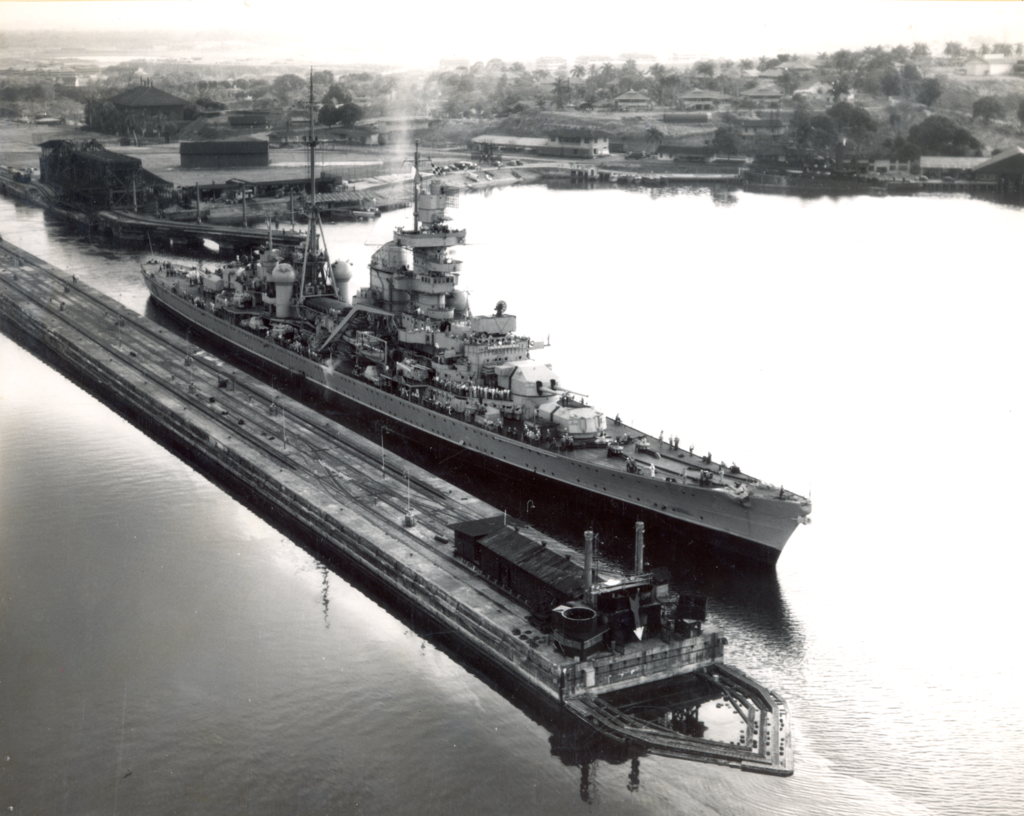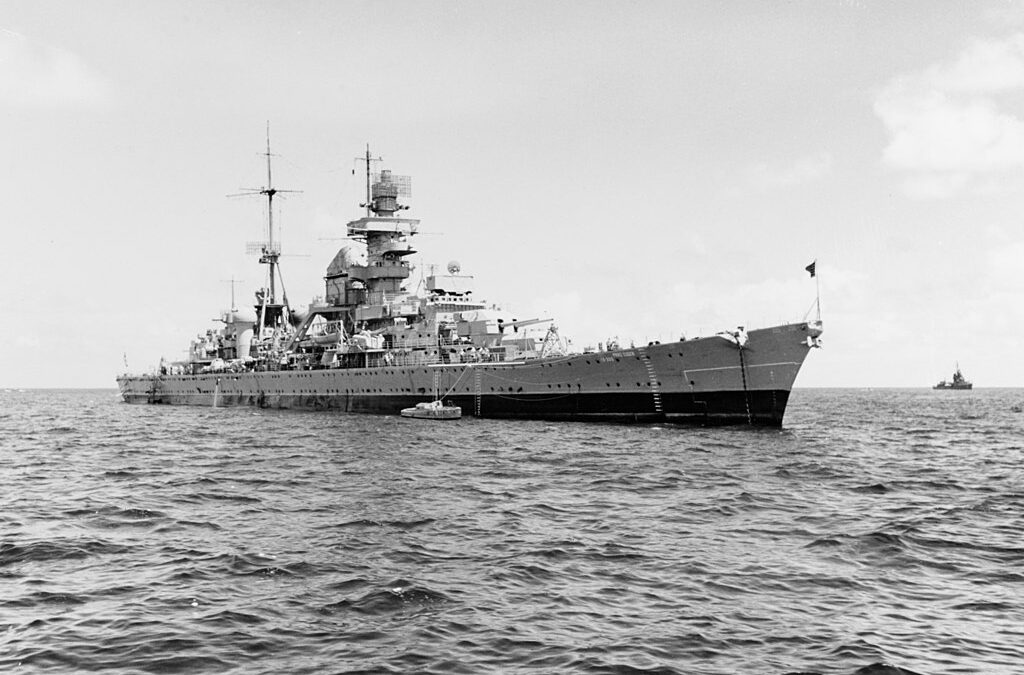Prinz Eugen lucky ship of the German Navy.
The heavy cruiser Prinz Eugen, third ship of the Hipper class, was launched at Kiel from the Gaarden dockyard of the Krupp Germania works on 22August 1938.The Ship was named after Prince Eugene of Savoy (1663-1736), the Austrian soldier statesman of the War of Spanish Succession noted defender of Europe against Turkish invasion. The ship was commissioned on 1 August, 1940, when her first Captain Hellmuth Brinkmann called the Prinz, as the ship became affectionately known by her crew ‘..a happy ship…’ and ‘…a lucky ship…’ which became her motto.
The Hipper class heavy cruisers nominally displaced 10,000 tons, but fully loaded weighed in at over 14,000 tons. Prinz Eugen had an overall length of 685ft and a beam of 72ft with a draught of 21ft and was slightly bigger than her earlier sister-ships. They all had steam turbines driving three shafts and could reach 34 knots. Armament consisted of eight 8inch guns in four twin turrets, as well as many AA guns. Also carried were twelve 21inch torpedo tubes in four triple mounts and three Arado 196 float planes.

In April 1941, shortly after completing sea trials, Prinz Eugen struck a mine which put her out of service for a month. This delayed the cruiser joining the battleship Bismarck, for operation ‘Rhine Exercise’. The new battleship one of the most powerful ever built was commissioned in August 1940; she was over 800 ft long with a displacement of 41,700 tons and mounted eight 15inch guns. Indeed both ships looked very similar in layout and would be confused by the British in action.
The battle group’s task, commanded by Admiral Gunther Lutjens was to attack British merchant shipping in the Atlantic they sailed from Bergen Norway on 21 May. Shortly before mid-night they emerged from the Norwegian Fiords and into the North Atlantic. All through 22 and 23 May Bismarck and Prinz Eugen pushed on through rain squalls and heavy clouds near the ice line that runs close to the Arctic Circle. Near the Denmark Strait dense fog banks further obscured their passage, an advantage, as night was of little help here in seas close to the midnight sun.

However on the evening of 23 May, suddenly the County Class Cruiser HMS Suffolk appeared on the edge of a fog bank seven miles ahead of Bismarck. Suffolk quickly turned back into the fog but the hunt was now on as she was tracking the German Ships on her new radar. She was soon joined by her sister ship HMS Norfolk.
Admiral Sir John C. Tovey, Commander of the British Home Fleet at Scapa Flow was ordered to stop the breakout. Including Suffolk and Norfolk he had two new battleships HMS King George V and HMS Prince of Wales, two battle cruisers HMS Hood and HMS Repulse the Aircraft Carrier HMS Victorious plus many other cruisers and destroyers. Also hurrying north to join him was the battleship HMS Rodney. On 21 May Hood and Prince of Wales had left Scapa Flow with six destroyers under the command of Admiral Lancelot Holland to provide heavy support to the cruisers covering the Denmark Strait, while the rest of the fleet gathered in the area between Iceland and the Orkney Islands.
About 0400hrs May 24 German lookouts spotted black smoke on the port beam and both ships were cleared for action. Prinz Eugen was steaming 600 yards in front of Bismarck. At 0530 Lutjens, who was under orders to avoid battle, ordered his ships to turn 45o to starboard almost due west.
However Holland’s ships were still closing the range, at 0540 it was some 26,000 yards, Holland knew Hood, being a battle cruiser, was vulnerable to plunging fire at long ranges with her thinly armoured decks and so he wished to pass through this critical zone quickly. He ordered his ships to turn 20o to starboard toward the enemy. This headlong dash, although reducing the range, and the profile of his ships to the enemy, masked eight of the British eighteen heavy guns. The German squadron were still not sure just what they faced although feared it was heavy units.
At 0552 Hood opened fire with her forward four 15inch guns at about twelve miles followed by six 14inch of Prince of Wales. Hood had fired at Prinz Eugen not Bismarck. Captain John C. Leach of Prince of Wales realised this mistake and ordered his guns to engage the second German ship. The arrival of these shells around the German Ships, in particular Hood’s being quite close to Prinz Eugen, confirmed they faced capital ships.
Lutjens with a fight on his hands ordered a 65o turn to port, and for his ships to open fire once the turn was complete. Thus Prinz Eugen opened fire first and began to pepper the Hood with eight inch shells from her fast-firing guns at four salvos a minute. After a few ranging salvoes Prinz Eugen hit the Hood her shells starting a large fire amidships.
Holland again turned his ships 20o to port as he was in danger of “having his T crossed”. This turn still placed the British at an acute angle of approach to the German ships and still unable to bring their rear turrets into action. Up to this point Bismarck had not hit Hood. Four minutes from the last turn Holland again turned his ships 20o to port enabling all guns to bear. Bismarck had now zeroed in on Hood firing three salvos in rapid succession. The first straddled Hood the next hit with devastating effect striking the area of the rear main turrets, a high flame was seen to shoot skyward near the mainmast aft of the rear funnel, had the shell penetrated the deck armour over the aft magazines? War Artist Lieutenant J.C Schmitz on board Prinz Eugen saw Hood blow up. ‘They were still firing as they blew up and fired to the end.’ Only three men out of the crew of 1,418 survived.
Able Seaman R. E Tilburn, one of Hood’s three survivors, insisted the first hit on Hood was by Prinz Eugen’s 8 inch guns and occurred at the base of the mainmast, and quickly developed into a bad fire. Another thing was the explosion Lieutenant Schmitz witnessed from Prinz Eugen, saying he saw Hood blow up but could not have heard it? Also Lieutenant Esmond Knight on board Prince of Wales observing Hood remembered ‘…thinking it would be a most tremendous explosion, but I don’t remember hearing an explosion at all.’
So what did happen to Hood? One theory is that Prinz Eugen’s 8inch guns firing at half their maximum range and her shells falling at a much steeper trajectory than Bismarck’s 15inch, one of her 8inch shells could have gone down Hood’s after funnel. The flimsy wire cage that covered the top of the funnel would not stop it. The next thing on the shells journey would have been a grating, positioned in vents at the level of the lower deck to protect the boiler room. If Prinz Eugen’s HE shell exploded here it would have been almost as bad as exploding in the boiler room. A HE shell bursting in one of the boiler rooms might have resulted in an enormous build up of heat and pressure resulting in an explosion inside the ship and the line of least resistance to this would have been up through Hood’s thin decks, not through her heavily armoured sides or bottom. Was this the result, a muffled explosion within the ship only heard below decks, the flash seen and Hood breaking in two? What happened to Hood will always remain a mystery.
Bismarck had been hit during the short engagement by Prince of Wales, resulting in a loss of fuel oil and taking in sea water near the bow tanks, this cut her speed. Forcing Lutjens to take the decision to head back to St. Nazaire with Bismarck while detaching Prinz Eugen to carry out the mission alone. They were still being shadowed by Suffolk and Norfolk with Prince of Wales.
Lutjen’s taking advantage of a fog bank in the early evening of May 24 turned Bismarck toward the pursuing ships. Emerging from the fog she opened fire on Suffolk. Prince of Wales was soon up in support firing at extreme range. But Lutjen’s had achieved his aim Prinz Eugen escaping south at full speed.
Fritz Otto Busch gives us a picture of this parting.
‘On the bridge of the Prinz everyone waited patiently and with considerable anxiety. Gradually it became clear to the men assembled there that they were seeing the flagship for the last time. Encircled by a halo from the salvoes of her own heavy turrets, militant and proud, she disappeared firing beyond the clear horizon.’
Two days later Prinz Eugen rendezvoused with the tanker Spichern to take on fuel. On 29 May she developed engine trouble while, Bismarck had been caught and sunk on 27 May. Investigations of the port engine revealed trouble with the low-pressure turbine. The mission had to be abandoned and a return to port at reduced speed was the only option. The lucky Prinz Eugen completely avoided the fate of Bismarck and reached Brest on 1 June. There it was hoped the cruiser would form a striking partnership with the battle cruisers Gneisenau and Scharnhorst. However all three ships became repeated targets for RAF bombers, and early in July Prinz Eugen was damaged. Thus all three ships were ordered to return to Germany.
To sail to Germany via the Atlantic might well have resulted in the fate suffered by Bismarck. Thus the bold but in many respects safer route of the English Channel was chosen.
In February 1942 the three ships made the “Channel Dash” under an umbrella of Luftwaffe fighter cover and destroyer escorts to reach their bases. At first the British were taken completely by surprise the ships left Brest at 23.00 on 11 February but were not spotted by RAF patrols until 11.42 on 12 February, although breakdowns by two RAF reconnaissance aircraft did not help. After their discovery some of the British attacks verged on the suicidal. Like the attack by six swordfish torpedo-bombers of 285 squadron, from Manston, Kent which attacked unsupported, all six aircraft were lost and only five of the twelve crew were picked up. Their flight commander Lieutenant-Commander E.Esmonde was awarded a posthumous Victoria Cross.
Gneisenau and Scharnhorst were damaged by mines but Prinz Eugen got through unscathed then her luck changed. A few days later off the coast of Norway she was torpedoed by the British Submarine Trident badly damaging the stern of the cruiser.
Divers soon found out the propellers had escaped damage but the rudder was missing and the bottom had been opened in several places. Temporary repairs were made in Norwegian waters. After which Prinz Eugen limped back to Kiel.
Prinz Eugen came under repeated air attacks as she made her way back to Germany at the reduced speed of eighteen knots, escorted by destroyers and ME 109 fighters. The attackers were torpedo-bombers, Beauforts, of No42 squadron the ship busters, based at Leuchars in Fife Scotland. Despite pressing home the attacks with great courage no hits were made on the limping cruiser.
The fitting of a new stern took until October 1942. In January 1943 Hitler ordered all heavy surface ships laid up. Grand Admiral Erich Raeder tried in vain to persuade Hitler to withdraw the order and lost his command in the process. His successor Grand Admiral Karl Donitz largely ignored the order, morale in the Prinz Eugen like other ships of the fleet plummeted. Reaching its lowest when in February the cruiser became a training ship for cadets. In August 1944 the cruiser returned to front line service sailing east toward the advancing Russians and operations in the Gulf of Riga. She was in constant action now giving gunfire support to the hard pressed ground forces and aiding in the evacuation of German civilians.
In October acting as the Flagship of “Battle Group Thiele” named after Vice Admiral Thiele, Prinz Eugen accidentally rammed the 6,000 ton light cruiser Leipzig. It occurred on a dark, misty night visibility was down to forty yards. Both ships had been blacked out against the threat of Russian submarines. A lookout cried a warning and the Captain Reinicke had rung for ‘…emergency full speed astern.’ But too late. The sharp high bow of Prince Eugan had driven into Leipzig between the light cruisers broad funnel and the bridge. Anti-aircraft crews standing near the point of impact were crushed. While in the engine room personnel were scalded with steam. The bows of Prinz Eugen were wedged into the port side of Leipzig. It took fourteen hours to separate the two ships with the aid of tugs. Repairs to Prinz Eugen were completed in just two weeks and in November 1944 she was back in action.
The cruiser was sorely needed for in October Riga had fallen and Russian troops entered East Prussia for the first time. At the end of the month the battleship Tirpitz, sister of Bismarck, was sunk by air attack in Norwegian waters. By then Prinz Eugen was the biggest and most modern unit in the fleet.
The heavy cruiser now supported the hard pressed German Army in the Gulf of Danzig. At Memel the Prinz fired 1,196 rounds of 8inch ammunition and 514 at Sworbe her heavy guns were practically worn out, requiring the replacement of the inner gun tubes which took fourteen days. In dock at Sworbe the town was packed with refugees, mostly women and children fleeing the advance of the Red Army.
Off Samland the heavy cruiser again covered the evacuation of mainly refugees who had been cut off on the peninsula, formed between Cranz and Konigsberg, by the advancing Russians.
Fritz Otto Busch describes the scene on the shore.
‘Many of the refugees, fearful of the Soviet soldiery and robbed of the power of cool deliberation by what they had already seen and experienced in the course of their long trek, could not wait. Men and women with children in their arms were plunging into the surf right among the ice-flows and battling with the sharp, jagged ice to reach the rescue boats, from which dazed, desperate, soaked through and frozen stiff they were pulled on board”. For three days Prinz Eugen with her sister ship Admiral Hipper covered the evacuation firing hundreds of rounds of 8inch ammunition. Hipper then limped to Kiel for a period in dry dock from which she never recovered.
In the last few months of the war Prinz Eugen was in constant action. In twenty-six days she fired 4,871 rounds of 8inch ammunition, and 2,664 rounds of 4inch, the barrels of the 8inch guns were practically worn out which had been refitted only a few months before.
The lucky Prinz Eugen had survived the war the only heavy unit of the German Fleet to do so; she was surrendered to the British at Copenhagen in May 1945. From Denmark Prinz Eugen with the light cruiser Nurnberg was escorted to Wilhelmshaven by Royal Navy cruisers.
At Wilhelmshaven Prinz Eugen was handed over to the American Captain A.H Graubart USN (who had been born on the River Weser) part of the Control Commission that decided the fate of the few remaining German Ships. This was done by drawing lots. Captain Graubart:
“I wrote the name of each lot on a piece of paper, folded the papers and put them in my cap. My British and Russian colleagues then each drew out a folded paper. And that is how I became commanding officer … of Prinz Eugen.’
In January 1946 Prinz Eugen sailed with a German-American crew to Boston and then with an all American crew through the Panama Canal into the Pacific, where she became one of the target test ships during the Atomic Bomb tests at Bikini Atoll in the summer of that year. The lucky ship of Hitler’s High Seas Fleet, luck had finally run out.
The German High Seas Fleet Badge with diamonds was established in 1941. This award was never bestowed, although a handful were manufactured. The criterion for the award was to serve as the Commander of a German Heavy Cruiser and or Battleship and also to be awarded the Knights Cross with Oak Leaves. During WWII no ‘big ship’ officer of the Kriegsmarine ever qualified, no doubt not helped by Hitler’s dislike of his surface fleet. Whereas the U Boat badge some thirty were awarded and eight to E Boat commanders.





